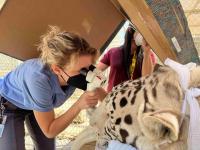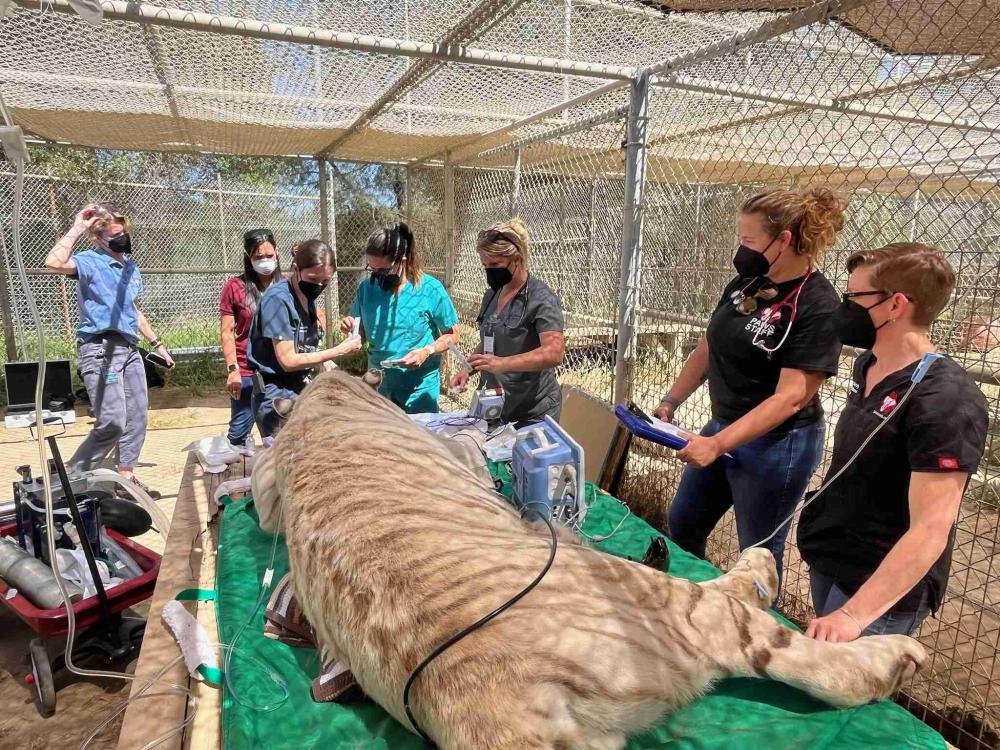
Ophthalmologists Treat White Tiger with New Laser Technology
“Case of the Month” – August 2024

Falcor, an 11-year-old, 412-pound white Bengal-hybrid tiger, lives a good life at the 2,300-acre Performing Animal Welfare Society (PAWS) sanctuary in San Andreas, California. With onsite veterinary care and a dedicated group of caretakers, PAWS is home to 26 rescued, abused, abandoned, or retired captive wild animals, including elephants, bears, primates, and other species.
Caregivers keep a close eye on all PAWS animals daily. They’re trained to look for any health issues whenever they feed, clean, or otherwise care for the animals.
In 2023, Falcor had a soft tissue sarcoma mass removed from around his left eye. The removal was accomplished with clean margins and no recurrence has been seen thus far.
“Since then, we always pay close attention to Falcor’s face, in particular,” said Dr. Jackie Gai (DVM ’01), PAWS director of veterinary services. “So, his caretakers noticed right away when a dark melanotic mass started growing on his right eyelid.”
Renae Smith, lead tiger supervisor, has been at PAWS for 17 years and was the first to notice.
“Renae knows the tigers inside and out,” said Dr. Gai. “She told us right away, and we knew we had to schedule a removal procedure immediately before the mass grew larger.”

Dr. Gai called the Ophthalmology Service at the UC Davis veterinary hospital. Thanks to donor support, the service recently acquired new laser equipment during the hiring process of Dr. Lauren Charnock, who was trained on the equipment during her comparative ophthalmology residency at Auburn University.
“Dr. Charnock has introduced this cutting-edge technology to our service, and we are now fortunate to be one of only a few veterinary hospitals that have this equipment,” said Dr. Kathryn Good, chief of the Ophthalmology Service. “We were thrilled about the opportunity to incorporate its use on Falcor.”
While PAWS has a state-of-the-art hospital on site, the team performed the procedure in Falcor’s enclosure to reduce the total time under anesthesia. The sanctuary is equipped with portable gas anesthesia, imaging, and other equipment that can easily be transported to the field.
After darting Falcor, Dr. Gai and her team quickly assembled a makeshift operating room in his enclosure. Joining Dr. Gai were fellow UC Davis alumnae Dr. Jennifer Glavis (DVM ‘09, MPVM ’10) and Lynn Dowling, RVT (BS Biology ‘13). The trio has worked together at PAWS for more than a decade. Dr. Glavis (part-time as a staff veterinarian) and Dowling (full-time as swing shift supervisor) also work at the UC Davis veterinary hospital.

The PAWS team was responsible for anesthesia induction and monitoring, blood collection, and other ancillary procedures, while Drs. Good and Charnock performed the tumor removal and laser therapy. Assisting from UC Davis were Sheri Tatham, RVT, Nikki Rochin, RVT, and ophthalmology resident Dr. Sara Adelman.
“There are so many PAWS and UC Davis links with Falcor’s medical team,” Dr. Gai stated. “I love being part of the great relationship between our two facilities.”
The specific laser treatment performed is called photodynamic therapy. At UC Davis, it has been used in horses, cats, dogs, and several other species, mostly with cancer on and/or around the eye.
Typically, the tumor is first surgically removed, as was done with Falcor. Then, a specific photo-sensitive dye is injected into the surgical site. The dye has therapeutic properties that are activated by the laser, which emits a particular light wavelength. The laser procedure creates an immediate scab that protects the area from infection, attempts to target and kill remaining cancer cells, and “seals” the surgery site without requiring sutures. Patients who receive this treatment tend to have minimal tissue swelling and appear quite comfortable after surgery. It also helps reduce the risk of tumor spread or regrowth by allowing doctors to remove more tissue in surgery, increasing the chance of obtaining clean margins during tumor removal.
Falcor’s anesthetization, comprehensive eye exam, and eyelid tumor surgery all took about 75 minutes. He remained stable throughout the procedure and is recovering well.
Most likely, no white tigers remain in the wild. Only one in 10,000 tiger births in the wild result in a white cub. Since there are approximately 5,000 wild tigers remaining, the chance of a white cub ever being born in the wild again is extremely rare.
The birth of a white tiger requires the recessive gene for white coloring to be carried by both the mother and father. All captive, and most likely all wild, white tiger births result from inbreeding.

Falcor is one of about 200 white tigers in captivity worldwide. The first recorded visualization of a white tiger occurred in India in the 1500s. In 1915, a white tiger was captured for the first time but was not bred. In 1951, another white tiger was captured in India and named Mohan. It was bred to a normal-colored tigress and produced three orange/black cubs. Those three cubs carried the recessive gene from Mohan. Mohan later mated with one of the cubs to produce the first litter of white cubs in captivity. All white tigers born in captivity descend from that litter.
Dr. Gai explained that the Association of Zoos and Aquariums or any other legitimate breeding organization does not support breeding for white tigers, as inbreeding leads to many disabilities and deformities.
“Not only is the white color recessive, but so are other conditions like dwarfism, cleft palate, vision problems, deformed limbs, and deformed facial features. With inbreeding, eventually, you end up with white tigers with too many health problems.”
Falcor’s melanoma was not necessarily the result of his inbreeding, but melanomas are a problem in white and/or gray animals. These animals can have higher incidences of melanoma than their more pigmented counterparts.
PAWS is doing all it can to keep Falcor’s future bright, but he has an infamous past. According to the PAWS website, he was “part of a major government action against the owners of a private zoo in Oklahoma, Jeff and Lauren Lowe (featured in the Netflix series “Tiger King”). The U.S. Department of Justice and the U.S. Department of Agriculture were involved in the action, and eventually 68 big cats were seized from the facility due to alleged violations of the federal Endangered Species Act and the Animal Welfare Act.”
PAWS is not open to the public but occasionally hosts open houses and other educational events. Please see their website for more details.
# # #

